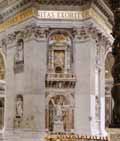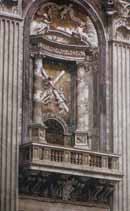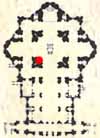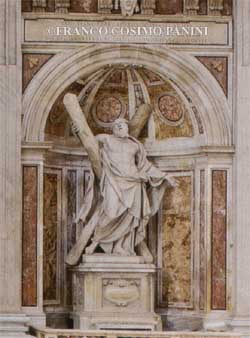| Grottoes
Vatican City Colonnade Saints Floorplan #2 |
| Altars
Monuments The History |
| Related
Items St Helen Statue Veronica Statue St Longinus Statue |
 |
 |
From: 'Guide to Saint Peter's Basilica'
Beneath the loggias of the relics Bernini created huge niches which hold
four colossal statues, almost 10 m. high, which are associated with the
relics. In the first pier on the right is the statue of St. Longinus,
the soldier who pierced the side of Jesus, from which "blood and water"
flowed. It was carved by Bernini in 1643 from four blocks of marble.
The dome above the papal altar is supported by four gigantic piers, 45 m. high with a perimeter of 71 m., started by Bramante and completed by Michelangelo. In 1624 Urban VIII commissioned Bernini to create four loggias in these piers. They are called the "Loggias of the Relics". Each is protected by a balustrade and adorned with two columns decorated with vine leaves and splendid bas-reliefs referring to the four "major relics". In fact, Urban VIII wanted him to carve out four niches in these loggias, where he then had placed the precious relics, formally kept but not properly preserved in the basilica.
The relics were: several fragments of the Cross of Jesus, which were found in the Roman churches of Santa Croce in Gerusalemme and Santa Anastasia, which in 1629 Urban VIII wished to be given to St. Peter's Basilica and placed in the pier of St. Helen; a scrap of material, showing the imprint of the face of a bearded man which had been brought by the crusades from Jerusalem to Rome and was already venerated before the 12th century; a fragment of the lance which was said to have belonged to St. Longinus and which Sultan Bajazet, the son of Mohomet II, had presented to Pope Innocent VIII (1492); St. Andrew's head, brought to Venice by Thomas Palaiolagos and donated to Pius II (1460).
The relics are now no longer in their original site, but the three relics of Our Lord's Passion are kept in the chapel above the statue of St. Veronica, and displayed to the people on the fifth Sunday in Lent. The relic of St. Andrew's head however, was sent by Paul VI as a gift to the Church of St. Andrew in Patras and a sign of friendship with the Greek Orthodox Church.
From: 'Guide to St Peter's Basilica' © 2003. Libreria
Editrice Vaticana
St Andrew (4.68m) by Francois Duquesnoy was unveiled before Urban VIII
on 2nd March 1640. It was the first out of the four statues in the piers
to be started. The saint is standing dynamically in front of a characteristic
cross, watching the sky in ecstasy. It took a long time to make it, because
the sculptor had to realize a second stucco model as the first one was
broken while it was being moved from his studio to St Peter's.
The transfer of the head of the Apostle to Rome was done thanks to Pius
II Piccolomini. After the Turkish invasion in the Peloponnese, the Pope
received the relic of the famous head from Thomas Palaiologos, the last
sovereign of Morea. The relic was taken by Cardinal Bessarione at Milvio
Bridge and then it was moved to St Peter's with a solemn ceremony on Palm
Sunday 12th April 1462. For safety, it was kept at Castle San Angelo,
and in 1464 it was placed in a tabernacle erected in the last left-hand
aisle of the Constantine Basilica. At the beginning of the next century
Francesco Bandini Piccolomini, Archbishop of Siena and Pius III Piccolomini's
grandnephew, continued his family tradition and adorned the altar with
a marble statue of the saint, at present in the entrance corridor to the
Sacristy. In 1966 Paul VI donated the relic to the city of Patras, where
St Andrew died.
Other Sources
St. Andrew, whose feast day is November 30th, is the patron saint for
fishermen. Andrew, like his brother, Simon Peter, was a fisherman. He
became a disciple of the great St. John the Baptist, but when John pointed
to Jesus and said, "Behold the Lamb of God!" Andrew understood that Jesus
was greater. At once he left John to follow the Divine Master. Jesus knew
that Andrew was walking behind him, and turning back, he asked, "what
do you seek?" When Andrew answered that he would like to know where Jesus
lived, Our Lord replied, "Come and see." Andrew had been only a little
time with Jesus when he realized that this was truly the Messiah.
From then on, he decided to follow Jesus. Andrew was thus the first disciple of Christ. Next, Andrew brought his brother Simon (St. Peter) to Jesus and Jesus received him, too, as His disciple. At first the two brothers continued to carry on their fishing trade and family affairs, but later, the Lord called them to stay with Him all the time. He promised to make them fishers of men, and this time, they left their nets for good. It is believed that after Our Lord ascended into Heaven, St. Andrew went to Greece to preach the gospel. He is said to have been put to death on a cross, to which he was tied, not nailed. He lived two days in that state of suffering, still preaching to the people who gathered around their beloved Apostle. Two countries have chosen St. Andrew as their patron - Russia and Scotland.


